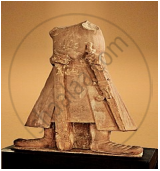Advertisements
Advertisements
Question
In which of the following regions Satvahanas rules during second century BCE to Second century CE?
Options
Northern and Deccan India
Western and Deccan India
Deccan and Eastern India
Eastern and Northern India
Solution
Western and Deccan India
Explanation:
The Satavahanas who ruled over parts of western and central India (c. second century BCE-second century CE).
APPEARS IN
RELATED QUESTIONS
Answer in 100-150 words
Compare and contrast the list of things given to the Pandyan chief (Source 3) with those produced in the village of Danguna (source 8). Do you notice any similarities and differences?
Source 3 :- (The Pandya chief Senguttuvan visits the forest)
This is an excerpt from the Silappadikaram, an epic written in Tamil:-
(When he visited the forest) people came down the mountain, singing and dancing ... just as the defeated show respect to the victorious king, so did they bring gifts – ivory, fragrant wood, fans made of the hair of deer, honey, sandalwood, red ochre,
antimony, turmeric, cardamom, pepper, etc. ... they brought coconuts, mangoes, medicinal plants, fruits, onions, sugarcane, flowers, areca nut, bananas, baby tigers, lions, elephants, monkeys, bear, deer, musk deer, fox, peacocks, musk cat, wild cocks, speaking parrots, etc. ...
Source 8 :- (Prabhavati Gupta and the village of Danguna)
This is what Prabhavati Gupta states in her inscription:- Prabhavati Gupta … commands the gramakutumbinas (householders/peasants living in the village), Brahmanas and others living in the village of Danguna ...
“Be it known to you that on the twelfth (lunar day) of the bright (fortnight) of Karttika, we have, in order to increase our religious merit donated this village with the pouring out of water, to the Acharya (teacher) Chanalasvamin … You should obey all (his) commands ...
We confer on (him) the following exemptions typical of an agrahara …(this village is) not to be entered by soldiers and policemen; (it is) exempt from (the obligation to provide) grass, (animal) hides as seats, and charcoal (to touring royal officers); exempt from (the royal prerogative of) purchasing fermenting liquors and digging (salt); exempt from (the right to) mines and khadira trees; exempt from (the obligation to supply) flowers and milk; (it is donated) together with (the right to) hidden treasures and deposits (and) together with major and minor taxes ...”
This charter has been written in the thirteenth (regnal) year. (It has been) engraved by Chakradasa.
Write a short essay (about 500 words) on the following:
Discuss the notions of kingship that developed in the post-Mauryan period.
Who composed the Prayag Prashasti in praise of Samudragupta?
Sangam is literature of ____________ language.
Harishena was the court poet of ____________.
Who among the following was the composer of ‘Prayaga Prashasti’?
Two statements are given in the question below as Assertion (A) and Reasoning (R).
Assertion (A): From c. 500 BCE norms were compiled in Sanskrit texts known as the Dharmasutras and Dharmashastras.
Reason (R): Brahmanas laid the codes of social behaviour for the society in general.
Match the following.
| List I | List II |
| A. Allahabad | 1. Commercial and political capital under Kushanas |
| B. Mathura | 2. Capital of Magadha |
| C. Puhar | 3. Samudragupta pillar inscription |
| D. Rajagaha | 4. Coastal town in South India |
Identify the given image from the following options.

